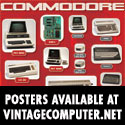Vintage Computing: a 1983 perspective
SHARE |
|
  Vintage Computing: a 1983 perspective
Vintage Computing: a 1983 perspective |
by Bill Degnan - 02/08/2008 17:33 |

FROM THE PRESIDENT by STEPHEN A. LONGO The Philadephia Area Computer Society, PACS, was founded in June 1976 by Dick Moberg. The Society was formed ...for the purpose of education and Intercommunication among computer users In the Greater Philadelphia area, and to inform the general public concerning computer technology and its Implications for the future. Membership is open to all persons interested in any aspect of computer arts and science..." (PACS charter). The meetings are on the third Saturday of the month. Except for the first couple of meetings, the monthly meetings have been held at LaSalle College. There are presently over one thousand members, many who are actively involved in more than one of the more than dozen special interest groups, SIGs. The SIGs represent all the major hardware manufacturers from Apple to Zenith, as well as software interests from CP/M to Pascal. In the mid-70s there were really no microcomputers nor any software systems as there are today. Back then one purchased chip sets: microprocessors, memory, and some logic chips. It was the days of homebrewing, rolling your own. One had to know a great deal of electronics; therefore, the first PACS members were generally engineers and ham radio operators. The engineers were mainly interested in using the microprocessor not as a computer, but as a simple electronic controller replacing dozens of discrete components. It was not the decrease In the part count, but the increase in flexibility that was causing the interest. That is, when a new job came along one did not buy another controller, one simply reprogrammed the standard controller. These microprocessors were teamed up with 1K or 4K memories. By today's standards that's nothing --too small to hold most languages, or even an operating system. That did not bother the engineers; all they wanted to do was to open a valve for a little while then close It, etc. The ham radio operators Interest was fun and excitement. Besides these hardware-freaks there were some main frame software addicts. These three groups--engineers, ham radio operators and software specialists--showed up at the early PACS meetings, all dreaming of owning their own systems. In those early days there were no special interest groups; there was only one Interest: to build a computer. A typical PACS meeting consisted of a flea market, a mapping session (questions), and a main meeting. We all crowded into the main meeting to listen to a guest speaker discuss how to build a system, or relate a failure (that is, how not to build a system). There were always more of the latter than the former. Occasionally we would have someone demonstrate a system that worked. One of the most exciting meetings was when Rob Smith brought in his homebrew computer! He designed and built the entire system; It was not a kit. The audience held Its breath as Rob, In order to better explain his system, pulled this part out, then that one, then shoved them back together--and the computer still worked! Some other events of interest during that first year were: show. It was held In August In Atlantic City, you had to be there! By the end of the first year PACS had one hundred members and some SIGs, namely: 6800, 6502, 8080, 8008, Medical Application and Digital Group 8080A. The SIGs reflected the times: The first four SIGS were hardware oriented, centered around specific microprocessors. The medical applications group was Dick Moberg. He was working at Jefferson Hospital and it was there that he met Karl Amatneek. Karl was the real motivator of microprocessor appliccations via IEEE meetings and seminars. This city owes him a great deal. The last SIG was a precursor of the next phase In PACS - the kits. The kits--Altalr, Digital Group, Imsal, Processor Technology, to name a few--have all passed-on. With kits, all, or most, of the electronics was figured out for you. The kit contributions were the printed circuit boards and a standard bus, the S-100. Now the emphasis shifted from chip sets to which were the best kits to buy, and how to connect your computer to the outside world--interfaclng. Mark Brindle's discussions on analog/digital conversions helped many members design their own interfaces. ...read entire article Reply |
|
Resources:

Popular Topics and FAQs
Past Issues:
Before we switched over to a blog format, past page archives here:
Vintage Computer Festival East 3.0 June 2006
Commodore B Series Prototypes July 2006
VOLSCAN - The first desktop computer with a GUI? Oct 2006
ROBOTS! - Will Robots Take Over? Nov 2006
Magnavox Mystery - a Computer, or? Jan 2007
The 1973 Williams Paddle Ball Arcade Computer Game Feb 2007
The Sperry UNIVAC 1219 Military Computer May 2007
VCF East 2007 - PET 30th Anniversary June/July 2007
The Electronic Brain August 2007
Community Memory and The People's Computer Company October 2007
Charles Babbage's Calculating Machine December 2007
Vintage Computing - A 1983 Perspective February 2008
Laptops and Portables May 2008
From Giant Brains to Hobby Computers - 1957 to 1977 August 2008
Historic Computer Magazines November 2008
World's Smallest Electronic Brain - Simon (1950) December 2008 - Feb 2009
Free Program Listings Spring 2009
Computer Music Summer 2009
Popular Electronics Jan/Feb 1975 - Altair 8800 Fall 2009
Early Microcomputer Mass Storage Summer 2010
Visual Commuter chassis removed

This image was selected at random from the archive. Click image for more photos and files from this set.